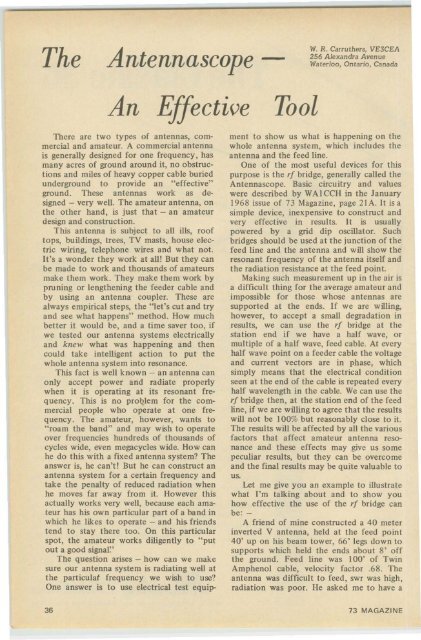rf - Free and Open Source Software
rf - Free and Open Source Software
rf - Free and Open Source Software
- No tags were found...
Create successful ePaper yourself
Turn your PDF publications into a flip-book with our unique Google optimized e-Paper software.
The<br />
Antennascope<br />
W. R. Carruthers, VE3CEA<br />
256 Alex<strong>and</strong>ra Avenue<br />
Waterloo, Ontario, Canada<br />
An E<br />
•<br />
ectice<br />
Tool<br />
There are two types of antennas, commercial<br />
<strong>and</strong> amateur. A commercial antenna<br />
is generally designed for one frequency, has<br />
many acres of ground around it, no obstructions<br />
<strong>and</strong> miles of heavy copper cable buried<br />
underground to provide an "effective"<br />
ground. These antennas work as designed<br />
- very well. The amateur antenna, on<br />
the other h<strong>and</strong>, is just that - an amateur<br />
design <strong>and</strong> construction.<br />
This antenna is subject to all ills, roof<br />
tops, buildings, trees, TV masts, house electric<br />
wiring, telephone wires <strong>and</strong> what not.<br />
It's a wonder they work at all! But they can<br />
be made to work <strong>and</strong> thous<strong>and</strong>s of amateurs<br />
make them work. They make them work by<br />
pruning or lengthening the feeder cable <strong>and</strong><br />
by using an antenna coupler. These are<br />
always empirical steps, the "let's cut <strong>and</strong> try<br />
<strong>and</strong> see what happens" method. How much<br />
better it would be, <strong>and</strong> a time saver too, if<br />
we tested our antenna systems electrically<br />
<strong>and</strong> knew what was happening <strong>and</strong> then<br />
could take intelligent action to put the<br />
whole antenna system into resonance.<br />
This fact is well known - an antenna can<br />
only accept power <strong>and</strong> radiate properly<br />
when it is operating at its resonant freq<br />
uency. This is no problem for the commercial<br />
people who operate at one frequency.<br />
The amateur, however, wants to<br />
"roam the b<strong>and</strong>" <strong>and</strong> may wish to operate<br />
over frequencies hundreds of thous<strong>and</strong>s of<br />
cycles wide, even megacycles wide. How can<br />
he do this with a fixed antenna system? The<br />
answer is, he can't! But he can construct an<br />
antenna system for a certain frequency <strong>and</strong><br />
take the penalty of reduced radiation when<br />
he moves far away from it. However this<br />
actually works very well, because each amateur<br />
has his own particular part of a b<strong>and</strong> in<br />
which he likes to operate - <strong>and</strong> his. friends<br />
tend to stay there too. On this particular<br />
spot, the amateur works diligently to "put<br />
out a good signal"<br />
The question arises - how can we make<br />
sure our antenna system is radiating well at<br />
the particulat frequency we wish to use?<br />
One answer is to use electrical test equip-<br />
ment to show us what is happening on the<br />
whole antenna system, which includes the<br />
antenna <strong>and</strong> the feed line.<br />
One of the most useful devices for this<br />
purpose is the <strong>rf</strong> bridge, generally called the<br />
Antennascope. Basic circuitry <strong>and</strong> values<br />
were described by WA ICCH in the January<br />
1968 issue of 73 Magazine, page 21 A. It is a<br />
simple device, inexpensive to construct <strong>and</strong><br />
very effective in results. It is usually<br />
powered by a grid dip oscillator. Such<br />
bridges should be used at the junction of the<br />
feed line <strong>and</strong> the antenna <strong>and</strong> will show the<br />
resonant frequency of the antenna itself <strong>and</strong><br />
the radiation resistance at the feed point.<br />
Making such measurement up in the air is<br />
a difficult thing for the average amateur <strong>and</strong><br />
impossible for those whose antennas are<br />
supported at the ends. If we are willing,<br />
however, to accept a small degradation in<br />
results, we can use the <strong>rf</strong> bridge at the<br />
station end if we have a half wave, or<br />
multiple of a half wave, feed cable. At every<br />
half wave point on a feeder cable the voltage<br />
<strong>and</strong> current vectors are in phase, which<br />
simply means that t he electrical condition<br />
seen at the end of the cable is repeated every<br />
half wavelength in the cable. We can use the<br />
<strong>rf</strong> bridge then, at the station end of the feed<br />
line, if we are willing to agree that the results<br />
will not be 100% but reasonably close to it.<br />
The results will be affected by all the various<br />
factors that affect amateur antenna resonance<br />
<strong>and</strong> these effects may give us some<br />
peculiar results, but they can be overcome<br />
<strong>and</strong> the final results may be quite valuable to<br />
us.<br />
Let me give you an example to illustrate<br />
what I'm talking about <strong>and</strong> to show you<br />
how effective the use of the <strong>rf</strong> bridge can<br />
be: -<br />
A friend of mine constructed a 40 meter<br />
inverted V antenna, held at the feed point<br />
40' up on his beam tower, 66' legs down to<br />
supports which held the ends about 8' off<br />
the ground. Feed line was 100' of Twin<br />
Amphenol cable, velocity factor .68. The<br />
antenna was difficult to feed, swr was high,<br />
radiation was poor. He asked me to have a<br />
36<br />
73 MAGAZINE

















